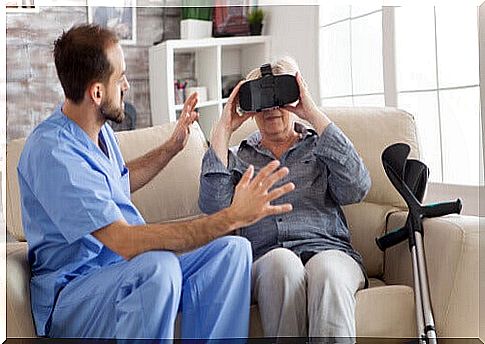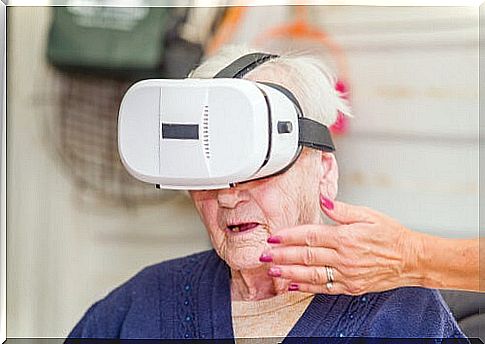Virtual Reality Applied To The Field Of Dementias

Virtual reality consists of the representation of scenes or images of objects, produced by a computer system that gives a feeling of their real existence. This technology allows you to dive into an artificially created world. And it takes experiences to another level, even allowing us to “put ourselves in the shoes” of another person (virtual incarnation).
The advancement of technology has allowed virtual reality to be applied to fields such as education or medicine. Specifically, we are going to focus on its application in the field of neurocognitive disorders, or dementias. In what way do you think virtual reality can improve the quality of life of these people? Let’s get out of doubt.

Entering the world of dementias
Dementias are acquired syndromes produced by an organic cause capable of causing a persistent deterioration of higher mental functions. This results in a functional disability.
They mainly affect executive functions, that is, memory, language, attention, reasoning ability, space-time orientation …
Usually, the disease begins to manifest itself with small forgetfulness in daily activities, short-term memory loss, disorientation, difficulty in performing certain tasks … As the disease progresses, it is common for problems to perform activities of daily living , behavioral problems and even difficulty in personal orientation.
Currently, the term “dementia” has been replaced by “neurocognitive disorders”. This has made it possible to broaden its definition and include milder degrees of affectation, considering not only those due to degenerative dementias. It has also made it possible to include dysfunctions in young people derived, for example, from head trauma.
Among the causes of neurocognitive disorders we find, among others: cortical dementias such as Alzheimer’s disease, Lewy body dementia, frontotemporal dementia, vascular dementia … and subcortical dementias, such as those caused by HIV, the disease Huntington’s disease, or Parkinson’s disease.
The WHO estimates that between 60 and 70% of the ten million cases of dementia are due to Alzheimer’s disease. It is estimated that in 2030 the number of people with dementia will rise to 76 million worldwide. And up to 130 million in 2050.
Research and early detection through virtual reality
The normal functioning of the neuronal mechanisms activated in spatial navigation is studied. This makes it possible to study the changes in this system over the years, detect alterations early and prevent their deterioration.
The mobile video game Sea Hero Quest became the largest dementia investigation in the world, with data from more than four million people, the equivalent of 12,000 years of investigation. With its leap to virtual reality, it allowed to obtain data of much greater precision.
Another example of this is a study carried out at the Center for Neurodegenerative Diseases in Bonn (Germany) in which it was shown that the level of ability of young people to navigate visual mazes can help predict the possibility of suffering from Alzheimer’s in the future.
Along the same lines, the Millennium Institute of Biomedical Neuroscience in Chile, through a virtual reality exercise that consisted of swimming until a hidden platform was found, was able to analyze early signs of Alzheimer’s disease, before the disease showed its face.
Virtual reality used to understand the disease and to train caregivers
On many occasions, as relatives of a person with dementia, we are not able to put ourselves in the place of the sick person. This can limit the quality of care we give you or it can even make us not so sensitive to your needs because we do not know them first hand.
In 2016, a Spanish company, Vyson, together with the Alzheimer’s Research Center (UK), created the virtual experience A walk through dementia. This experience allows you to put yourself in the shoes of a person with dementia and experience the difficulties they experience in their daily activities. What better way to raise awareness than to experience it in the first person?
In Chicago, Carrie Shaw, the daughter of an Alzheimer’s patient, founded Embodied Labs and designed simulations that allowed her to train family members, caregivers and health workers: prepare them for the changes that could occur as the disease developed. He believed that if caregivers or therapists were able to put themselves in the place of the sick, they would be better caregivers.
Cognitive stimulation and dementia treatment through virtual reality
Virtual reality and augmented reality are fields still under investigation. But, fortunately for these patients, quite encouraging results have been obtained and open a door to finding a cure for dementia. As stated by Diego Redolar, director of the Cognitive Neurolab at the Hospital de la Santa Creu i Sant Pau in Barcelona, the application of virtual reality techniques in the initial moments of the disease can help to slow it down.
Virtual reality is not only used to promote cognitive stimulation and increase cognitive reserve, but its use is also very important for improving mood. It is very promising from the affective and emotional point of view. As Redolar explains, one of the first areas affected in Alzheimer’s disease is the hippocampus and the neurons that make it up.
Stimulating this area can help improve the mood of these patients. The Way Back, designed by Andy Garnett, is a series of short films in which, through virtual reality, elderly people with Alzheimer’s are taken to happy moments in their lives and given the opportunity to relive historical moments. In this way, it is possible to carry out the miniscence therapy, which allows to strengthen the identity of the patients.
In addition, behavior and impulse control problems may begin to appear later in the disease . At this point, virtual reality is used as a way to reassure patients. It reduces your stress and anxiety levels by up to 70%, as stated by one of the companies that developed this type of tool, Tribermex . It is a very effective distraction technique in these cases.

A great step for the man and a great step for the disease
As much as we sometimes feel like true slaves of technology, being forced to be up-to-date, the truth is that technological advancement offers us opportunities that a few years ago were only imaginable in the script of a futuristic science fiction movie.
Virtual reality is not a cure for the disease either, but all the research and data it provides allow us to be one step closer to finding a solution every day. For now, it will be necessary to settle for tools and treatments that improve the quality of life and slow down the progression of the disease, which is no small thing, and improve the mood of patients, as well as the training of their caregivers.
If it is for these purposes, I think it pays to be a slave to technology.









